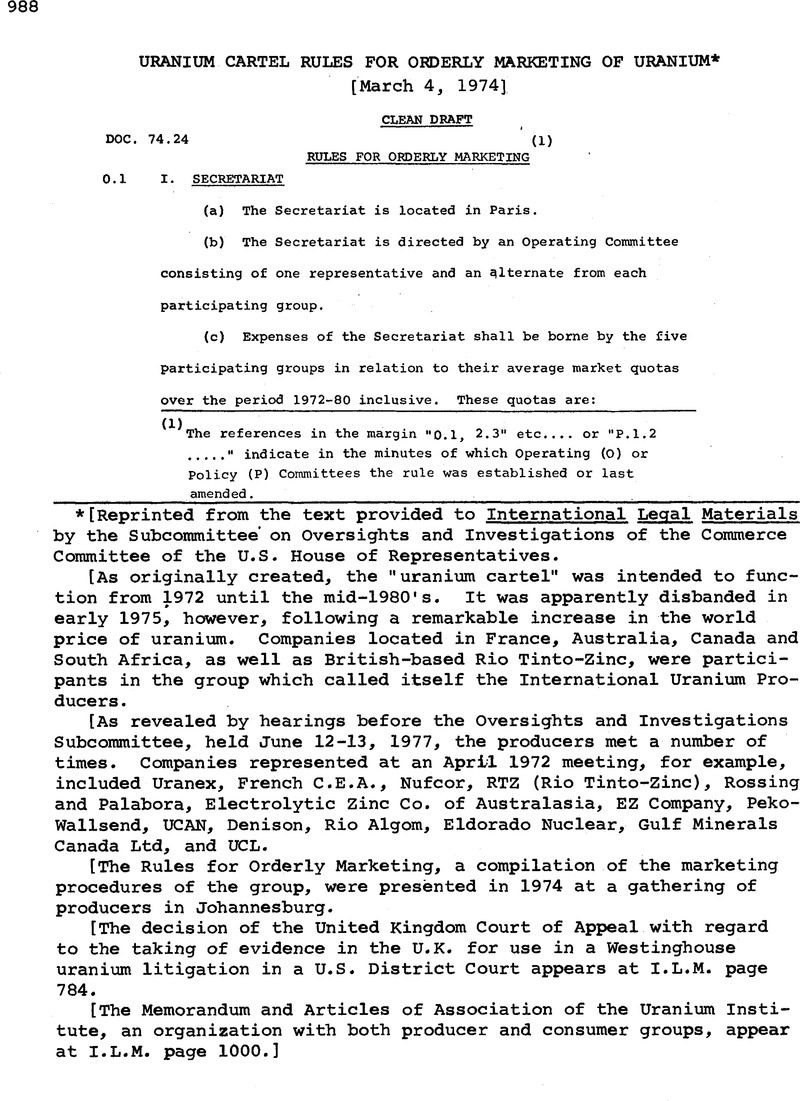No CrossRef data available.
Published online by Cambridge University Press: 20 March 2017

[Reprinted from the text provided to International Legal Materials by the Subcommittee’ on Oversights and Investigations of the Commerce Committee of the U.S. House of Representatives.
[As originally created, the “uranium cartel” was intended to function from 1972 until the mid-1980's. It was apparently disbanded in early 1975, however, following a remarkable increase in the world price of uranium. Companies located in France, Australia, Canada and South Africa, as well as British-based Rio Tinto-Zinc, were participants in the group which called itself the International Uranium Producers.
[As revealed by hearings before the Oversights and Investigations Subcommittee, held June 12-13, 1977, the producers met a number of times. Companies represented at an April 1972 meeting, for example, included Uranex, French C.E.A., Nufcor, RTZ (Rio Tinto-Zinc), Rossing and Palabora, Electrolytic Zinc Co. of Australasia, EZ Company, Peko- Wallsend, UCAN, Denison, Rio Algom, Eldorado Nuclear, Gulf Minerals Canada Ltd, and UCL.
[The Rules for Orderly Marketing, a compilation of the marketing procedures of the group, were presented in 1974 at a gathering of producers in Johannesburg.
[The decision of the United Kingdom Court of Appeal with regard to the taking of evidence in the U.K. for use in a Westinghouse uranium litigation in a U.S. District Court appears at I.L.M. page 784.
[The Memorandum and Articles of Association of the Uranium Institute, an organization with both producer and consumer groups, appear at I.L.M. page 1000.]
* [Reprinted from the text provided to International Legal Materials by the Subcommittee’ on Oversights and Investigations of the Commerce Committee of the U.S. House of Representatives.
[As originally created, the “uranium cartel” was intended to function from 1972 until the mid-1980's. It was apparently disbanded in early 1975, however, following a remarkable increase in the world price of uranium. Companies located in France, Australia, Canada and South Africa, as well as British-based Rio Tinto-Zinc, were participants in the group which called itself the International Uranium Producers.
[As revealed by hearings before the Oversights and Investigations Subcommittee, held June 12-13, 1977, the producers met a number of times. Companies represented at an April 1972 meeting, for example, included Uranex, French C.E.A., Nufcor, RTZ (Rio Tinto-Zinc), Rossing and Palabora, Electrolytic Zinc Co. of Australasia, EZ Company, Peko- Wallsend, UCAN, Denison, Rio Algom, Eldorado Nuclear, Gulf Minerals Canada Ltd, and UCL.
[The Rules for Orderly Marketing, a compilation of the marketing procedures of the group, were presented in 1974 at a gathering of producers in Johannesburg.
[The decision of the United Kingdom Court of Appeal with regard to the taking of evidence in the U.K. for use in a Westinghouse uranium litigation in a U.S. District Court appears at I.L.M. page 784.
[The Memorandum and Articles of Association of the Uranium Institute, an organization with both producer and consumer groups, appear at I.L.M. page 1000.]